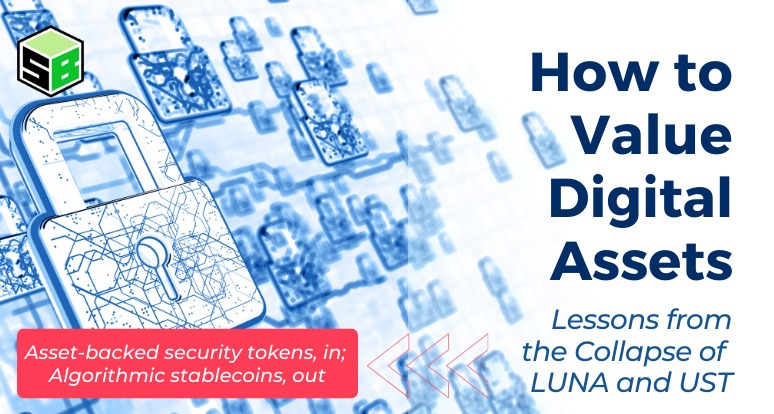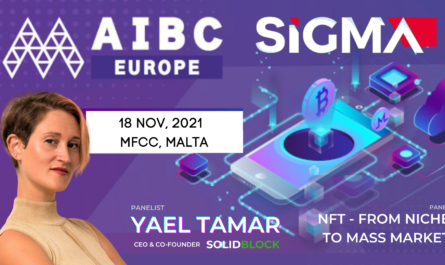Lessons from the Collapse of LUNA and UST – Asset-backed security tokens, in; algorithmic stablecoins, out

Last month saw the dramatic demise of Terraform Lab’s LUNA and UST stablecoin that, due to panicked trading on a normally quiet weekend, unpegged UST from its 1:1 dollar exchange rate. The collapse began with a drop in the value of LUNA, a cryptocurrency that was the financial instrument supporting UST.
UST is a type of stablecoin, a currency that is pegged or tied, to that of another currency, commodity or financial instrument. There are three types of stablecoins: debt-backed, asset-backed, and algorithmic. In the case of UST, and DEI, the stablecoin by DEUS Finance, which dropped below $0.60, both were backed by algorithms.
Terra’s public fumble is drawing out negative misconceptions about blockchain and fintech in general. Members of the public have taken to social media to express their discontent. One account with more than 6,000 followers harassed a SolidBlock employee over the weekend. Calling on his followers to shame tokenization, he referred to tokenization as a “scam” and a “pump and dump scheme.” We see this uninformed opinion as an opportunity to help others learn more about the distinctions between different blockchain financial products by contrasting stablecoins and security tokens.
“I am not surprised by trolls,” explains Lydia Scherr, SolidBlock’s Web3 Research Lead. “This situation highlights the pressing need to continue educating others on the differences from one blockchain product to another.”
For some people, blockchain equals crypto, and all crypto is the same. Taking a closer look, however, it quickly becomes obvious that this assumption couldn’t be farther from the truth. For example, LUNA’s UST is an algorithmic stablecoin. Comparing that to asset-backed security tokens is like comparing apples to oranges.
All Stablecoins are not the same. As an algorithmic stablecoin, Terra’s UST is not directly backed by the US dollar, though it was pegged to dollar exchange. The most popular stablecoins, like Tether or USDC, are backed by dollars and these survived UST and LUNA’s crash.
Asset-backed security tokens on the other hand are registered securities with the Securities and Exchange Commission (SEC) that act as fractional ownership of an asset. Blockchain is used in both cases because it enhances liquidity and transparency in transactions.
In short, even though both stablecoins and digital real estate securities are blockchain financial products, they are serving different purposes, and are collateralized in different ways.
For the reader who wants a more in-depth understanding, you must first consider the differences between cryptocurrencies and other tokens. It is important to note that there are actually three kinds of tokens: payment tokens, NFTs, and digital securities. Here’s our primer on how these tokens work:
Payment Tokens
Bitcoin is obviously the most recognized cryptocurrency on the market, followed close behind by Ethereum, Tether, Dogecoin, Litecoin, Polkadot, Cardano… You get the picture. These are tokens that act like money. One Bitcoin is equal in value to another Bitcoin. And the market determines the exchange rate between a Bitcoin and a dollar. Each of these cryptocurrencies has an inherent value based on many factors, just as a dollar has a different value than a Franc or a British pound.
The value of stablecoins, as mentioned above, is pegged, or tied, to that of another currency, commodity, or financial instrument. Last week, the algorithmic UST also plunged LUNA, the cryptocurrency that was meant to help the UST stablecoin keep its dollar peg, into collapse.
NFTs
NFTs are non-fungible tokens. The value of an NFT is based entirely on demand. That value is shaped by several different factors.
Rarity: What makes this NFT unique? Is it the only one? Is it part of a series? Does it depict someone famous or was it created by or previously owned by a famous individual? Or does it have a specific real-world utility?
Practicality: Perhaps your NFT is valuable either because it connects to a real-world asset (like a virtual Picasso that is linked to the original masterpiece) or because it is a dynamic object from a specific game that you play. As more people play this game alongside you, the value of your NFT, be it a plot of land, a card, or a weapon, increases.
SolidBlock has recently introduced an NFT hotel booking system with a real-world utility called NFTstays, a platform to increase revenue and occupancy rates with an NFT marketing system for hotels and resorts.
NFTstays mints a predetermined number of NFTs that show unique art and include an allotted number of night stays at the hotel, along with a choice of perks and benefits. The NFTs plug into the hotel’s existing booking program. This is the first time NFTs have been used for hotel bookings in the United States.
Tangibility: Many popular NFTs do not have a real-world use. Therefore, your interest in them may be more in the realm of the intangible. Does owning your NFT give you personal satisfaction? Do you have an emotional attachment to it? Does it please you? Imagine an iconic image of your favorite sports figure actively scoring an awesome number of points—and you own it. These are all tangible sides of the intangible nature of virtual tokens.
Additionally, as with any investment, part of the intrinsic value of an NFT is derived from its short- and long-term resale value.
Digital Securities
Here we introduce SolidBlock’s raison d’etre. SolidBlock is a platform for Tokenization as a Service (TaaS). We create digital securities. We tokenize real-world assets like real estate that endows each token with a more secure and stable value.
Digital securities are a digital representation of ownership of an underlying asset. They are securities; they are not a digital currency, cryptocurrency, or commodities.
Tokenization is a tool for wealth managers to better their business. Tokenization can unlock the liquidity of your asset. It can also reduce transaction and asset management fees. A 2020 report conducted by Finoa and Cashlink shows cost savings of 35-65% for tokenization over time compared to traditional securitization. They analyzed legal and transaction structuring pre-issuance; issuance services and transactions in the primary market; life-cycle management of assets (custody and asset servicing); and trading of assets on the secondary market. They concluded that due to the decentralized financial nature of tokenization, transactions do not require issuance agents or investor management to be centrally involved. Peer-to-peer transactions save time and money.
Digital securities share characteristics with cryptocurrencies and NFTs in that they all run on blockchain technology. But unlike their sister tokens, digital securities are a tokenized representation of ownership of an underlying real-world asset. The value of the token is backed by the value of the asset.
A type of digital ledger technology (DLT), blockchain ensures that data cannot be tampered with and provides a secure and encrypted means of recording all of a token’s ownership details. It also assists in chronicling the books and records associated with a property, allowing for easier accounting and asset management.
Moving Forward
The collapse of LUNA and UST was watched by millions of people around the world, and we do think there will be consequences. First, the government bodies that want to regulate stablecoins will probably act more quickly to do so. Recent comments by SEC Chairman Gary Gensler that more investors could experience significant losses in a crypto market if stablecoins continue to falter, coupled with US Treasury Secretary Janet Yellen’s comments along the same lines, mark part of the frustration that investors feel at the slow pace of the American government’s decision on how it will regulate digital assets. The United States is behind other leading global economies in providing clarity on regulation, causing a problem for investors.
According to a Korean report, the Korean National Assembly’s Political Affairs Committee summoned Terraform Labs co-founder Do Kwon for a parliamentary hearing regarding the issue, and may prosecute if they discover misdeeds. It looks like Korean cryptocurrency exchanges are now likely to be held accountable for failing to implement measures to protect investors from the crash. Terra will also face charges of fraud in South Korea by a group of LUNA and UST investors. There are reports that Do Kwon led his company with a flagrant and bombastic cult of personality that did not heed warnings as early as 2018 when Terraform’s white paper describing the algorithmic stablecoin was published.
Second, angry trumpeted voices that called the LUNA collapse a Ponzi scheme are wrong. “Affixing the Ponzi label to anything that doesn’t work in digital assets is incredibly tiresome,” writes Jeff Dorman, CFA, on the Arca blog site. “The LUNA/UST peg mechanism was experimental but very transparent. It had both strong supporters and harsh critics. Many consumers and investors avoided the risks; others knew the risks and decided the risk/reward was worth it.”
Most significantly, cryptocurrencies, NFTs, and digital securities will continue to develop new and more practical use cases. Even the recent comments of Sam Bankman-Fried, the founder of FTX crypto exchange platform, referring to bitcoin’s complicated payment system and environmentally costly operations, did not, as mainstream media would like us to think, abandon cryptocurrencies. In our opinion, he was calling for technological advances to solve these issues.
Mike Novogratz, director of the crypto merchant bank Galaxy Digital, and an avid investor in both Bitcoin and LUNA, has seen his net worth plummet by roughly $6 billion since early November. Novogratz, though, remains a crypto optimist.
“Crypto is not going away…Our community is resilient, has a shared belief in a new way of doing things, and the assurance that this is the very early innings,” he wrote in a recent letter to investors, breaking his silence after TerraUSD’s collapse.
We know that going from zero interaction with these technologies to even just one is difficult for a wide swath of the population. But we also believe there will be an increase in the adoption of tokenization—with digital securities leading the way—as an additional tool for wealth management in real estate transactions.
About SolidBlock
Founded in 2018 and headquartered in Israel, SolidBlock is a leader in Tokenization as a Service (TaaS) for real estate. As blockchain fuels change in the way real estate is transacted, the tokenization of real-world assets on SolidBlock’s platform empowers asset owners to transact differently—buy, sell, raise capital, and collateralize—and to manage their tokenized property on a secure, immutable, transparent system.
SolidBlock provides the tools that unlock the value of an asset’s liquidity and administer the records for every real estate transaction on the blockchain. SolidBlock’s real estate tokenization platform is a bridge to a decentralized financial (DeFi) ecosystem and the Web3 blockchain economy.

 by
by 

